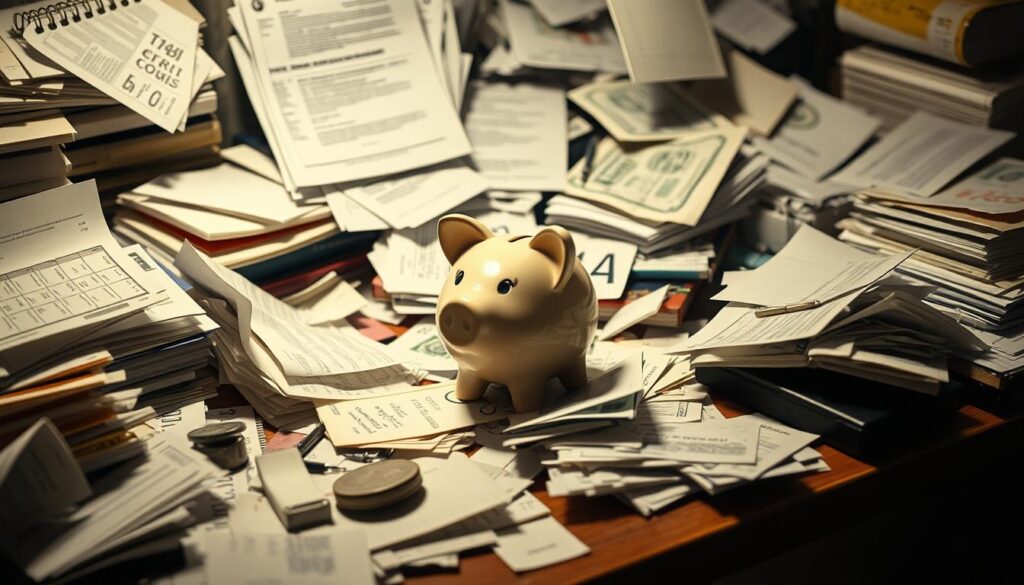Build an Emergency Savings Fund Tips vs Strategies Creating an emergency fund is key to financial stability and security. It acts as a safety net against unexpected expenses like job loss or medical emergencies. By saving for emergencies, you can cover unexpected costs without stress.

Having an emergency fund gives you peace of mind. It lets you focus on long-term goals like retirement or buying a home. In this article, we’ll cover why emergency funds are important. We’ll also share tips on starting and growing your fund, focusing on both emergency funds and savings strategies.
Introduction to Emergency Funds
Emergency funds are crucial for a solid financial plan. They help you deal with unexpected expenses and setbacks. By saving for emergencies, you’re ready for life’s surprises and can handle financial challenges confidently.
Key Takeaways
- Emergency funds provide a safety net against financial shocks and uncertainties, and are a key part of financial planning.
- Building an emergency fund requires a well-planned savings strategy, including effective savings strategies.
- Effective financial planning and emergency fund management can reduce financial stress and anxiety, through the use of emergency fund and savings strategies.
- A strong emergency fund provides peace of mind and allows individuals to focus on long-term financial goals, using emergency fund and savings strategies as part of a comprehensive financial planning approach.
- Regularly reviewing and adjusting emergency fund savings is crucial to maintaining financial stability, and is an important aspect of emergency fund and savings strategies.
- Emergency funds should be easily accessible and liquid, to ensure quick access to funds in case of an emergency, as part of a comprehensive emergency fund and savings strategy.
Understanding Why Emergency Savings Matter
Having a safety net can help reduce the costs of financial emergencies. These emergencies can greatly affect your financial health. It’s crucial to understand the value of emergency savings to protect yourself from life’s uncertainty.
An emergency fund gives you peace of mind. It acts as a buffer, helping you deal with sudden expenses without debt. Key benefits include:
- Less stress and worry about financial emergencies
- More ability to handle uncertainty and surprises
- More peace of mind knowing you have a safety net
By focusing on emergency savings, you prepare for life’s surprises. This leads to more financial security and stability.
Determining Your Emergency Fund Goal
Setting a realistic savings target is key in financial planning. Your emergency fund goal should match your income, expenses, and debt. To figure out the right size for your emergency fund, think about these factors:
A common advice is to save 3-6 months’ worth of living costs in a savings account you can easily reach. This number can change based on your job stability, family size, and other financial duties. For instance, if you have a steady job, you might aim for the lower end. But if your income varies or you’re self-employed, aim for the higher end.
Here’s how to set your emergency fund goal:
- Figure out your monthly living costs, like rent, utilities, food, and transport.
- Think about how stable your income is and how secure your job is.
- Look at your debt, including credit cards, loans, and mortgages.
- Choose a savings target that fits your situation.
By following these steps, you can plan your emergency fund and move closer to your financial planning goals. Always check and update your emergency fund goal as your financial situation changes.
How to Build an Emergency Savings Fund Tips vs Strategies: Essential Steps
Having a safety net for unexpected costs is key to financial stability. Start by setting up a dedicated savings account for your emergency fund. This keeps your savings separate from your daily spending, making it easier to track your progress and avoid using your emergency fund for non-essential items.
After setting up your dedicated savings account, create automatic transfers from your main checking account. This ensures you add to your emergency fund regularly, even if it’s a small amount each month. Keeping track of your progress is also crucial. It helps you stay motivated and see how close you are to your savings goal.
- Set a realistic savings goal and create a plan to achieve it
- Take advantage of high-yield savings accounts or other accounts that offer competitive interest rates
- Review and adjust your budget regularly to ensure you’re making progress towards your goal
By following these steps and staying consistent, you’ll build a strong emergency fund. This fund will give you peace of mind and financial security.
Smart Ways to Jump-Start Your Emergency Fund
To boost your emergency fund, try some smart savings strategies. Selling items you no longer need is a great start. It not only clears your space but also adds cash to your fund.
Using tax refunds for your emergency fund is another smart move. It builds a strong base for your savings. Plus, a side job can bring in steady money, helping your fund grow.
Here are some effective ways to kickstart your emergency fund:
- Selling unwanted items to generate quick cash
- Using tax refunds to create a solid savings foundation
- Taking on a side hustle to increase income and contribute to your emergency fund
By using these strategies, you can quickly grow your emergency fund. Always check and tweak your plan to stay on track. This way, you’ll reach your financial goals and keep your finances stable.
Choosing the Right Account for Your Emergency Fund
Choosing the right account for your emergency fund is key. You want to earn more while paying less in fees. There are many options, each with its own pros and cons.
High-yield savings accounts offer higher interest rates, helping your money grow. Money market accounts provide easy access to your funds with debit cards or checks. Traditional savings accounts might have lower fees but earn less interest.
- Fees associated with the account
- Interest rate and potential earnings
- Accessibility and ease of use
- Minimum balance requirements
By looking at these factors and what you need, you can choose wisely. Whether it’s a high-yield savings, money market, or traditional account, pick one that fits your financial goals. This will help you achieve stability in the long run.
Common Obstacles in Emergency Fund Building
Building an emergency fund is tough, and many people face big hurdles. Financial setbacks like job loss or medical emergencies can quickly use up savings. Also, saving can be hard due to lack of motivation or other financial needs.
Financial setbacks are especially tough because they need quick action. To beat these challenges, it’s key to know what’s holding you back. You might need to create a budget for unexpected costs or build a support network for help when needed.
Some common savings hurdles include:
- Lack of motivation or discipline to save regularly
- Competing financial priorities, such as paying off debt or saving for retirement
- Insufficient income or irregular income streams

By tackling these savings challenges, you can keep moving towards your emergency fund goals. With determination and the right approach, anyone can beat these obstacles. This way, you’ll have a safety net and peace of mind.
Balancing Emergency Savings with Other Financial Goals
Creating a solid financial plan means balancing emergency savings with other goals. This includes paying off debt, investing, and planning for retirement. It’s key to know how important each goal is and to allocate funds wisely. Having enough emergency savings helps protect against unexpected costs or financial troubles.
When it comes to debt, focus on high-interest ones first, like credit card balances. These should be paid off quickly. Lower-interest debts, like mortgages, can be tackled over time. Meanwhile, investing in a retirement plan, like a 401(k) or IRA, offers long-term benefits and tax savings.
Some important things to keep in mind when balancing your finances include:
- Set aside a portion of your income for savings, debt, and investments.
- Make realistic plans and timelines for each goal.
- Keep an eye on your plan and make changes as needed to stay on track.
By looking at your finances as a whole and balancing your goals, you can build a stable and secure financial future.
Making Your Emergency Fund Work Harder
To make your emergency fund more effective, you need to use smart emergency fund optimization strategies. Consider investing in low-risk options like bonds or money market funds. This way, you can earn returns while still having quick access to your money. This approach helps your emergency fund grow and work harder for you.
Another way to boost your emergency fund is by using savings strategies like savings apps or automatic transfers. These tools simplify saving money by setting aside a part of your income regularly. Also, don’t miss out on employer matching programs, like those in 401(k) or other retirement accounts, to grow your emergency fund.
Here are some important tips to make your emergency fund more effective:
- Regularly check and adjust your emergency fund to match your financial goals.
- Look into other savings options, like high-yield savings accounts or CDs.
- Plan a long-term investment strategy to support your emergency fund and overall finances.
By using these strategies and focusing on emergency fund optimization and savings strategies, you can boost your financial growth. This will help you build a stronger financial base for yourself.
When to Use Your Emergency Fund
Having an emergency fund is key, but knowing when to use it is just as important. Emergency fund usage should be for real emergencies only. This includes unexpected medical bills, car repairs, or losing a job. Using it for non-essential things can hurt your financial discipline and leave you unready for real emergencies.
To keep your emergency fund strong, it’s vital to know what counts as a true emergency. Here are some tips to help:
- Medical emergencies, such as hospitalization or surgery
- Car repairs or replacement
- Loss of income due to job loss or illness
- Natural disasters, such as hurricanes or earthquakes
By knowing what a true emergency is and being careful with your emergency fund, you can stay on track. This way, your emergency fund will be there when you really need it.

Replenishing Your Emergency Fund After Use
It’s key to rebuild your emergency fund after using it. A smart emergency fund replenishment plan helps you bounce back fast. First, look at your spending and make a budget. Include a part for savings strategies to keep moving forward.
Use big money like tax refunds or bonuses to help fill your fund. You can also earn more by getting a side job or selling things you don’t need. This way, you’ll get your emergency fund replenishment back on track faster.
- Check your budget to find ways to spend less
- Set a goal for when you want to refill your fund
- Make saving automatic
Stick to thesesavings strategies and keep up with your financial recovery. You’ll fill your emergency fund well and keep your finances safe.
Advanced Strategies for Long-term Fund Maintenance
As you grow your emergency fund, think about long-term strategies. This includes inflation protection to keep your savings up with living costs. Regular checks and tweaks are key to keep your fund effective over time.
Reviewing and adjusting your savings is crucial. Look at your income, expenses, and goals to see if your fund needs a boost or a trim. This way, your emergency fund stays in sync with your finances.
- Investing in assets that provide inflation protection, such as index funds or real estate
- Setting aside a portion of your emergency fund for regular review and adjustments
- Considering alternative savings options, such as high-yield savings accounts or money market funds, to optimize your emergency fund’s growth
Using these advanced strategies, your emergency fund will stay a key part of your financial plan. It will give you peace of mind and financial security for the future. Always focus on emergency fund maintenance and inflation protection to protect your savings and achieve financial stability.
Conclusion: Securing Your Financial Future Through Emergency Savings
Building an emergency savings fund is key to protecting your financial future. By using the tips and strategies from this article, you can build a strong emergency fund. This fund gives you peace of mind and stability.
Putting emergency savings first in your financial plan leads to long-term financial security. It helps you reach your financial goals smoothly, without worrying about unexpected costs.
Having a solid emergency fund lets you face life’s surprises with confidence. It helps you stay focused on your financial goals. By building this important safety net, you’re making a big step towards a secure financial future for yourself and your family. Building an emergency savings fund provides financial security and peace of mind, reducing stress in uncertain situations. With this stability, you can prioritize self-care, like taking a digital detox weekend to unwind and recharge.
FAQ
What is the importance of building an emergency savings fund?
An emergency savings fund is key to protect against sudden financial issues. This could be job loss, medical bills, or unexpected repairs. It acts as a financial safety net, giving you peace of mind. This way, you can handle unexpected expenses without going into debt or touching your long-term savings.
How much should I have in my emergency fund?
The general rule is to save 3-6 months’ worth of living expenses. But, the right amount for you depends on your job stability, family needs, and debt level.
What are the steps to build an emergency savings fund?
To start, open a dedicated savings account. Next, set up automatic transfers from your checking account. Lastly, keep track of how close you are to your savings goal.
How can I jump-start my emergency fund?
There are quick ways to grow your emergency fund. You can sell items you no longer need, use tax refunds, or take on a side job. These strategies can help you start saving fast and build momentum.
What type of account should I use for my emergency fund?
High-yield savings, money market, and traditional savings accounts are good choices. Think about interest rates, how easy it is to access your money, and any fees when picking the best account for you.
When should I use my emergency fund?
Use your emergency fund only for real emergencies. This includes job loss, medical bills, or big repairs. Don’t use it for everyday expenses or things you want but don’t need.
How do I protect my emergency fund from inflation?
To shield your savings from inflation, invest some in low-risk assets. Short-term bonds or money market funds are good options. This way, your savings can keep its value over time.
How often should I review and adjust my emergency fund?
Check your emergency fund at least once a year. Or, anytime your financial situation changes, like a new job or more expenses. Update your savings goal as needed to keep your fund strong.
Based on
https://www.vox.com/even-better/396840/emergency-fund-savings-expenses-financal-goals-budget?utm
https://bettermoneyhabits.bankofamerica.com/en/saving-budgeting/emergency-fund-tips?utm
https://www.thesun.co.uk/money/33367284/how-save-money-children-penny-day-challenge/?utm
